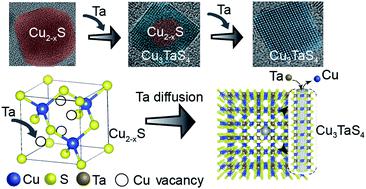当前位置:
X-MOL 学术
›
J. Mater. Chem. A
›
论文详情
Our official English website, www.x-mol.net, welcomes your feedback! (Note: you will need to create a separate account there.)
Vacancy assisted growth of copper tantalum sulfide nanocrystals
Journal of Materials Chemistry A ( IF 11.9 ) Pub Date : 2022-06-06 , DOI: 10.1039/d2ta02714c Anamul Haque , Soheil Ershadrad , Trupthi Devaiah C , Dipankar Saha , Biplab Sanyal , Pralay K Santra
Journal of Materials Chemistry A ( IF 11.9 ) Pub Date : 2022-06-06 , DOI: 10.1039/d2ta02714c Anamul Haque , Soheil Ershadrad , Trupthi Devaiah C , Dipankar Saha , Biplab Sanyal , Pralay K Santra

|
Cu-based ternary chalcogenides have received significant interest as an alternative to conventional photovoltaic materials. CuInS2 and CuInSe2 are the most studied copper-based ternary chalcogenides for photovoltaics. Recently, copper tantalum sulfide (CuTaS3) has been proposed as a potential light absorber for photovoltaics. The synthesis conditions and growth mechanism of ternary systems control the final composition and crystal structure. However, such studies have not been explored for copper tantalum sulfides. Here, we studied the formation and growth mechanism of Cu3TaS4 nanocrystals (NCs) primarily using X-ray diffraction, transmission electron microscopy, and density functional theory (DFT) calculations. The reactions proceed via the formation of cubic Cu2−xS NCs due to soft Lewis acid – soft Lewis base interaction. The Cu2−xS have Cu vacancies, which can be controlled by the relative concentration of the Cu precursor. Ta incorporation occurs in the Cu2−xS NCs at Cu vacancy sites, followed by the diffusion of Ta by replacing Cu into the lattice. Low packing of atoms in Cu3TaS4 provides suitable diffusion channels for Ta and Cu atoms. The diffusion barriers of Ta atoms outweigh that of Cu atoms, implying a reaction rate controlled by Ta diffusion. Thus by varying the relative Cu precursor concentration, the concentration of Cu-vacancies in Cu2−xS can be tuned, which controls the growth rate of Cu3TaS4. Understanding of the growth mechanism obtained in this paper will significantly contribute to the rational synthesis of various Cu-based ternary chalcogenides that is not possible by direct synthesis and hence will have an impact on potential applications in photovoltaics and photocatalysis.
中文翻译:

空位辅助生长硫化铜钽纳米晶体
铜基三元硫属化物作为传统光伏材料的替代品受到了极大的关注。CuInS 2和CuInSe 2是研究最多的用于光伏的铜基三元硫属化物。最近,已提出硫化铜钽(CuTaS 3 )作为光伏的潜在光吸收剂。三元体系的合成条件和生长机理控制着最终的组成和晶体结构。然而,尚未对铜钽硫化物进行此类研究。在这里,我们研究了Cu 3 TaS 4的形成和生长机制。纳米晶体 (NC) 主要使用 X 射线衍射、透射电子显微镜和密度泛函理论 (DFT) 计算。由于软路易斯酸-软路易斯碱相互作用,反应通过形成立方 Cu 2- x S NCs 进行。Cu 2- x S 具有Cu 空位,可以通过Cu 前体的相对浓度来控制。Ta 掺入发生在 Cu 空位的 Cu 2- x S NCs 中,然后通过将 Cu 置换到晶格中来扩散 Ta。Cu 3 TaS 4中原子的低堆积为 Ta 和 Cu 原子提供合适的扩散通道。Ta原子的扩散势垒大于Cu原子的扩散势垒,这意味着反应速率受Ta扩散控制。因此,通过改变相对的Cu前体浓度,可以调节Cu 2- x S中Cu空位的浓度,从而控制Cu 3 TaS 4的生长速率。对本文中获得的生长机制的理解将大大有助于合理合成各种铜基三元硫属化物,这是直接合成无法实现的,因此将对光伏和光催化中的潜在应用产生影响。
更新日期:2022-06-06
中文翻译:

空位辅助生长硫化铜钽纳米晶体
铜基三元硫属化物作为传统光伏材料的替代品受到了极大的关注。CuInS 2和CuInSe 2是研究最多的用于光伏的铜基三元硫属化物。最近,已提出硫化铜钽(CuTaS 3 )作为光伏的潜在光吸收剂。三元体系的合成条件和生长机理控制着最终的组成和晶体结构。然而,尚未对铜钽硫化物进行此类研究。在这里,我们研究了Cu 3 TaS 4的形成和生长机制。纳米晶体 (NC) 主要使用 X 射线衍射、透射电子显微镜和密度泛函理论 (DFT) 计算。由于软路易斯酸-软路易斯碱相互作用,反应通过形成立方 Cu 2- x S NCs 进行。Cu 2- x S 具有Cu 空位,可以通过Cu 前体的相对浓度来控制。Ta 掺入发生在 Cu 空位的 Cu 2- x S NCs 中,然后通过将 Cu 置换到晶格中来扩散 Ta。Cu 3 TaS 4中原子的低堆积为 Ta 和 Cu 原子提供合适的扩散通道。Ta原子的扩散势垒大于Cu原子的扩散势垒,这意味着反应速率受Ta扩散控制。因此,通过改变相对的Cu前体浓度,可以调节Cu 2- x S中Cu空位的浓度,从而控制Cu 3 TaS 4的生长速率。对本文中获得的生长机制的理解将大大有助于合理合成各种铜基三元硫属化物,这是直接合成无法实现的,因此将对光伏和光催化中的潜在应用产生影响。

























 京公网安备 11010802027423号
京公网安备 11010802027423号